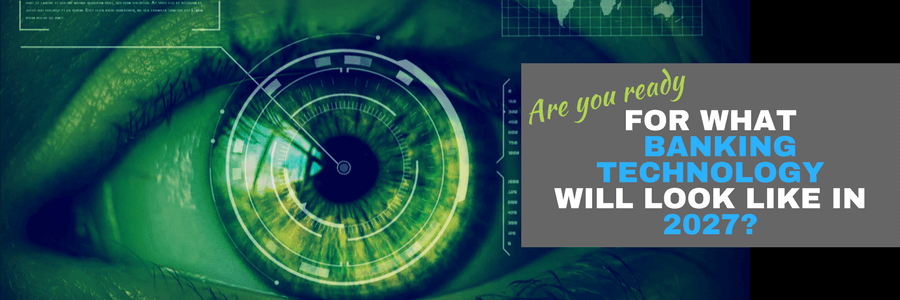By Dayna Carlin, Marketing Executive
Can you recall what it was like before all this new banking technology began taking over? Do you remember actually going to your bank branch to open a checking account?
Today, consumers can open accounts on the subway, their couch, or even on their toilets. Who would’ve known that in a short 10-year period technology would change the way an industry operates and interacts with customers.
I was fortunate enough to attend the American Bankers Association Convention in Chicago. During the show, I sat in on the Banking 2027 Panel. The panel speakers presented five technologies that they predict will transform the banking industry over the next decade.
1) Biometrics as a Banking Technology
Makes you think, huh? I heard this and started to scratch my head. How do measurements and/or calculations of someone’s body apply to banking?
Wells Fargo said they don’t want customers to take time to enter their password, or if they forget it, have to go through the dreadful, “forgot my password process.” So, they decided to apply biometrics to the login process on mobile devices. Pretty cool, right?
Wells Fargo customers can log in to the Wells Fargo app by simply looking at the app with CEO Mobile® Biometrics.
Each person’s “eye print” is unique to them, creating a secure, discreet, and easy way to access banking information. Talk about easy computing. Secil Watson, EVP Head of Wholesale Internet Solutions at Wells Fargo predicts that passwords will disappear in two years.
I can see how this innovative banking technology could really be leveraged to stop fraud, help obtain contracts, and more.
2) Digital Lending
A customer-centric approach to banking includes not only customer-facing activities but the back-office operations as well. Today, a lot of banks solely focus on applying their digital investments to improve customer-facing activities such as onboarding and credit checks by leveraging mobile apps.
Unfortunately, many banks pay less attention to digitizing the back office. They are stuck with paper processes and the only way to stay relevant and competitive is to practice digital lending.
Chris Rentner, CEO of Akouba, gave one example of this. “We have the ability to pull tax returns automatically from the IRS, so your back office doesn’t have to track down the CFO or anyone from the customer’s team.” As the Marketing Executive at Pyramid Solutions, it is exciting to me that we have been providing digital lending solutions similar to Rentner’s to our clients for years. This banking technology is here! Make the investment.
3) Monetizing Data You Already Have
Wait, what? What does that actually mean? Brian Lay, CEO at Alphrank, showcased how Alphrank helps banks define influencer trends and patterns within their customer base.
By leveraging data such as spending habits, banks can act more like the big boys — Facebook, LinkedIn, Twitter — and use social graphs to identify influencers within specific social groups. By knowing who the influencers are, banks can target them with specific campaigns such as adopting a mobile app, new service, or simple plan updates to accelerate adoption rates.
Coming from a marketing background, it’s music to my ears to hear that companies are taking segmentation to the next level and leveraging data they’ve received from their banking technology implementations to make smart advertising and marketing decisions. Consumers pour out information about their buying habits every day. We just have to take the time to listen, analyze, and act.
4) IBM Watson Artificial Intelligence
You may think of artificial intelligence (AI) as robots that take over jobs, but that’s simply not true. In reality, it can be applied as an innovative banking technology.
As an IBM Business Partner, and from working with Watson in our own solutions, I see the true potential of AI in not only banking but across all industries.
During the panel Marc Andrews, VP IBM Watson Financial Services Solutions, showcased four new Watson applications for banking that are pretty darn cool:
- Managing Regulatory Change – Watson can read through all changing and new regulations, interpret them, and provide the potential obligations you as a bank have to address.
- Identifying Conduct Issues – Watson can review and assess client and employee emails, chats, activities, and communications to flag and identify any misconduct taking place.
- Know Your Customer – Watson streamlines the “due diligence” activities on your customers.
- Anti-Money Laundering – Watson can reduce false positives within your transaction monitoring system by reading, reviewing, and accessing your alerts.
5) Internet of Things (IoT)
Did you know, as of today there are six billion IoT devices on the market?! AND they’re expecting it to rise to 20 billion within three years! Crazy, right?
Doug Leighton, SVP, Head of Community and Regional Accounts at Visa, showed us how Visa leverages IoT by equipping the cars we drive with our credit cards to pay for meter parking as you pull up to a meter, guesstimate how much gas you’re going to need and pay for it as you pull up to a pump, pay for fast food, and more.
Why is this important to bankers? Because these devices will be payment-enabled. That means tomorrow’s bankers will need to be ready to move token-enabled accounts to these devices.
As a consumer and someone involved in the software side of banking technology, it’s exciting to see what lies ahead and is already here. People and companies with visionary ideas like using biometrics, and Watson, monetizing data, and joining the internet of things, make banking an exceptional experience for us.
These are just snippets of information from the Banking 2027 session — I encourage you to watch the full panel discussion here.
About the Author: My favorite thing about working at Pyramid Solutions is that I get to work with teams that push boundaries and think of outside-the-box ideas that not only help our clients but revolutionize the industries we operate in. When not working, you can find me at a Crossfit gym exercising and hitting new personal records.

